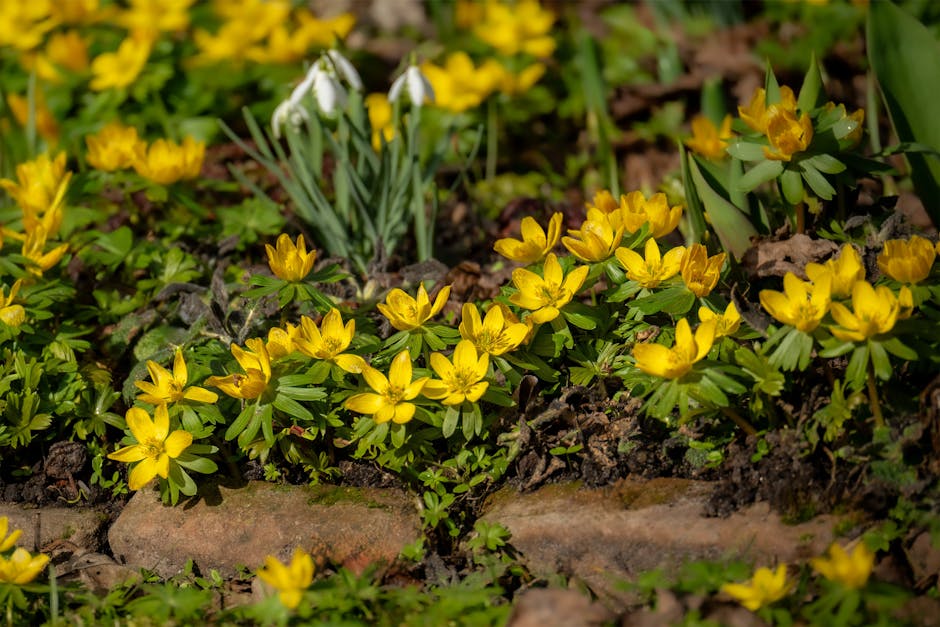
15 Flowering Ground Cover Plants to Enhance Your Landscape
Ground cover plants are invaluable in landscaping, offering solutions to common challenges while adding beauty to your outdoor space. Whether you’re dealing with a steep slope, shaded areas under trees, or the need for a low-maintenance border, ground covers can transform problem areas into stunning focal points. Flowering ground covers, in particular, combine functionality with aesthetic appeal, providing vibrant blooms alongside practical benefits like weed suppression and erosion control.
Imagine replacing a section of your high-maintenance lawn with a carpet of colorful, low-growing plants that require minimal care. Not only can these plants reduce yardwork, but they also create visual interest, especially when in bloom. In this guide, we’ll explore 15 flowering ground cover plants that can elevate your garden, each chosen for its unique characteristics and ability to thrive in various conditions. From creeping thyme to sweet woodruff, discover the perfect options to create a lush, vibrant landscape.
What Are Ground Cover Plants?
Ground cover plants are low-growing species that spread to form dense mats, effectively covering the soil. Their height can range from just a few inches to over two feet, but their defining feature is their function: creating a continuous expanse of foliage that suppresses weeds and protects soil from erosion. These plants often spread through creeping stems or clumping growth habits, making them ideal for filling in bare spots or replacing traditional lawns.
When planning to integrate ground covers into your landscape, consider pathways for easy movement and check local regulations, as some fast-growing species may be considered invasive in certain regions. Selecting native or well-adapted plants ensures vigorous growth and minimal maintenance.
Our Favorite Flowering Ground Covers
1. Bugleweed (Ajuga reptans)
A perennial in the mint family, bugleweed thrives in USDA Zones 3 to 10, preferring average to moist soil and partial to full shade. Reaching up to 6 inches tall, it features glossy leaves often tinged with purple and spikes of blue to white bugle-shaped flowers blooming from May to June. Evergreen in warmer climates, it’s perfect for shady borders or underplanting.
2. Canadian Anemone (Anemone canadensis)
This native perennial spreads well in Zones 3 to 8, growing 1 to 2 feet tall in full sun to part shade. Its bright green, toothed leaves complement individual white blossoms, making it a striking choice for naturalized areas or woodland gardens.
3. Candytuft (Iberis sempervirens)
A woody, mounding perennial, candytuft grows to about 12 inches in Zones 3 to 8, thriving in full sun with well-drained soil. Its sweetly scented white flower clusters bloom from April to May, often obscuring the elongated green leaves beneath. Evergreen in milder climates, it’s ideal for borders and rock gardens.
4. Creeping Phlox (Phlox subulata)
Also known as moss phlox, this native perennial creates a bold carpet of pink, blue, or white flowers in Zones 3 to 9. Standing about 2 inches tall (up to 6 inches when blooming from March to May), it’s evergreen and tolerates light foot traffic, making it excellent for slopes or garden walls.
5. Creeping Thyme (Thymus praecox)
A wild variety of the herb thyme, this woody perennial reaches 3 inches in height and is hardy in Zones 4 to 8. It thrives in full sun with well-drained soil, offering tiny pink-purple blossoms from June to July. Perfect between stepping stones, it releases a minty aroma when walked on and is drought-tolerant.
6. Deadnettle (Lamium maculatum)
Thriving in part to full shade in Zones 3 to 8, deadnettle features variegated green and silvery-white leaves with pink flowers from May to July. Heights vary from a few inches to 2 feet, and its drought tolerance makes it great for narrow spaces or rockeries.
7. Hosta (Hosta sieboldiana)
Known as plantain lilies, hostas are reliable perennials for Zones 3 to 8, preferring shade and rich, damp soil. Their foliage ranges from solid green to variegated, with tall spikes of white or purple flowers from May to July. Heights vary, with some exceeding 2 feet, ideal for shady borders.
8. Horned Violet (Viola cornuta)
These annuals (perennials in temperate climates) grow 6 to 8 inches tall in Zones 6 to 11, showcasing scented two-toned purple and blue flowers from April to June. They thrive in full sun to part shade with average soil, perfect for edging or containers.
9. Japanese Pachysandra (Pachysandra terminalis)
An evergreen perennial for Zones 5 to 9, Japanese pachysandra grows to 12 inches in part to full shade. Its glossy, whorled leaves and spikey white flowers in April make it ideal for under shrubs or trees, hiding bare soil and preventing erosion.
10. Liriope (Liriope spicata)
Also called lily turf, this hardy perennial reaches 1 to 2 feet in Zones 5 to 10, with grass-like foliage and spikes of tiny blue, white, or purple flowers in August and September. Thriving in sun or shade, it’s excellent for borders and erosion control on slopes.
11. Lithodora (Lithodora diffusa)
Perfect for Zones 6 to 8, lithodora grows up to 12 inches with small, hairy leaves and bright blue flowers blooming vigorously in May and sporadically through August. It prefers part shade and well-drained soil, tolerating light foot traffic.
12. Pig Squeak (Bergenia cordifolia)
Named for the sound its leaves make when rubbed, this perennial grows over 12 inches in Zones 3 to 8, thriving in part to full shade. Its shiny, dark green leaves and pink flower stalks bloom in April and May, offering drought tolerance for challenging spots.
13. Spike Speedwell (Veronica spicata)
A clumping perennial for Zones 3 to 8, spike speedwell reaches over a foot tall with tall spikes of purple, blue, pink, or white flowers from June to August. It prefers full sun and moist, well-drained soil, creating vibrant color swaths.
14. Sweet Woodruff (Galium odoratum)
This fragrant perennial for Zones 4 to 8 grows to 8 inches, blooming star-like white flowers in May and June. Preferring part to full shade with moist soil, it naturalizes rapidly, making it a lovely underplanting for shrubs in woodland gardens.
15. Wishbone Flower (Torenia fournieri)
Also known as bluewings, this annual thrives in part to full shade across Zones 2 to 11, with trumpet-shaped flowers in purple, pink, white, and yellow blooming all summer. It prefers moist, well-drained soil, adding color to shady garden areas.
Designing with Flowering Ground Covers
Ground covers offer versatility in garden design, tackling irregular terrain and serving as an attractive alternative to traditional grass lawns. They act as natural weed barriers and help camouflage fading foliage of other plants when interplanted. For the best results, choose native or well-adapted varieties to minimize maintenance and maximize vigor.
Mix different ground covers to create a dynamic palette of color, texture, and height. Consider evergreen options for year-round interest and pay attention to mature heights—low-growers are perfect between paving stones, while taller varieties suit borders or slopes. With thoughtful selection, you can create rich, varied carpets of color that transform your landscape into a feast for the eyes.
Conclusion
Flowering ground cover plants are a game-changer for any gardener looking to enhance their outdoor space with minimal effort. Whether you’re drawn to the vibrant blues of lithodora or the fragrant charm of sweet woodruff, there’s a ground cover to suit every garden style and condition. Which of these plants will you incorporate into your landscape? Share your ideas and experiences in the comments below—we’d love to hear how flowering ground covers play a starring role in your garden!







